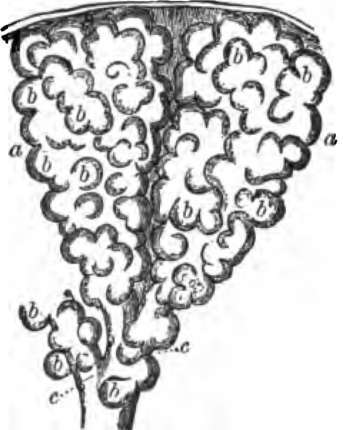Structure Of The Windpipe And Its Branches
Description
This section is from the book "The Human Body: An Elementary Text-Book Of Anatomy, Physiology, And Hygiene", by H. Newell Martin. Also available from Amazon: The Human Body.
Structure Of The Windpipe And Its Branches
The trachea, bronchi, and bronchial tubes are lined by mucous membrane, outside of which is a supporting stratum composed of connective and plain muscular tissues. Their walls also contain cartilaginous rings or half-rings which keep them open. Below the projection on the throat known as Adam's apple (due to the larynx, see Chap. XXIV.) there may readily be felt in thin persons the stiff windpipe passing down to the top of the chest.
The Cilia Of The Air Passages
The mucous membrane of the trachea and its branches, down to almost the smallest, has a layer of ciliated cells on its surface. Each of these cells has on its end turned towards the cavity of the tube a tuft of from twenty to thirty slender threads which are in constant motion; they lash forcibly towards the throat, move gently back again, and then once more violently towards the outlet of the air-passage. These moving threads are called cilia. Swaying in the mucus secreted by the membrane which they line, they sweep it on to the throat, where it is coughed or " hawked " up.
Imagine a man rowing in a boat at anchor. The sweep of the oars will drive the water back and not the boat forwards. So these little oars, the cilia, being anchored on the mucous membrane drive on the secretion which bathes its surface.
With what are the windpipe and its branches lined? What lies outside this lining? What do these walls also contain? What is the use of the cartilages? What is " Adam's apple"? What may be felt below it in front of the neck?
What lines the mucous membrane of the windpipe and its subdivisions? What does each ciliated cell bear on its free end? How do the threads move? What are they called? What is the use of the cilia of the air-passages?
Illustrate how they push on the liquid they move in.

Fig. 66. Two alveoli of the lung highly magnified, b, b, the air-cells, or hollow protrusions of the alveolus, opening into its central cavity; c, terminal branches of bronchial tube.
Bronchitis, or "a cold on the chest," is an inflammation of the membrane lining the bronchial tubes, in consequence of which it swells, and secretes an extra amount of mucus. The swelling and secretion tend to close the tubes and interfere with the free passage of air in breathing.
Continue to:
